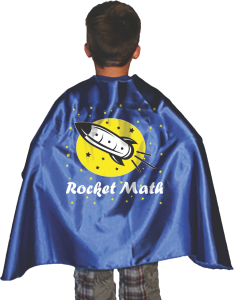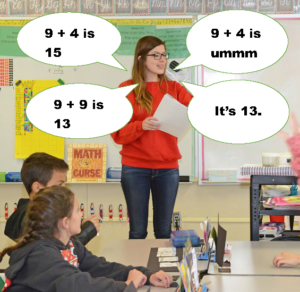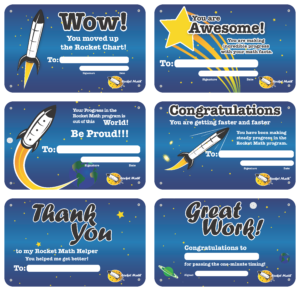Why supplement the Online Tutor? The Online Tutor works best if your students are motivated and your teachers have all the support they need. Purchasing these two key supplements will make the Online Tutor far more effective. Make sure your purchase gets the job done.
(1) Motivate your students to use the Online Tutor.
 The Wall Chart motivates within the classrooms.
The Wall Chart motivates within the classrooms.
Motivated students will use the Rocket Math Online Tutor more frequently and make more progress. The Wall Chart can motivate students on a daily basis. It motivates by having students work together to reach a common goal. Students receive stickers when they pass a level and get the honor of adding their sticker onto the class chart. The teacher sets goals for rows filled by a certain date. If the class fills the rows before the date, the teacher rewards the class in some fashion. (You can read the suggestions for use here.)
The Wall Chart helps monitor engagement easily.
As a math coach or administrator, the Wall Chart helps you quickly assess if a class is using the Online Tutor. Visit a classroom, look at the Wall Chart, praise the class for their efforts and give them a principal “Principal Free Space” by adding a different colored sticker of your own. Then you can revisit the class in a week or two and easily see how much they have accomplished since your last visit. Then you can praise the class and the teacher, or show a little disappointment if it is not happening. This supplement to the Online Tutor is very helpful.
 The Super Hero Rocket Math cape helps motivate across the school.
The Super Hero Rocket Math cape helps motivate across the school.
When students complete a Learning Track (or other milestone of achievement), they get to wear one of the Rocket Math capes around school, at lunch or out to recess. Everyone can see that they have accomplished something in Rocket Math. It’s especially effective for students who haven’t been getting onto the Online Tutor and so haven’t had a chance to wear the Super Hero cape. It’s also great for adults to notice and praise the student who has accomplished something in Rocket Math. Healthier for students than candy prizes and it is re-usable.
(2) Provide support and guidance to your teachers.
Teachers need support, help, and guidance to make the most of the Online Tutor. This support package provides help in four ways. This is in addition to the video series “Making the best use of the Online Tutor.”
(First) Get a one-hour remote in-service training session with Dr. Don
Dr. Don will train your teachers. Teachers can get either initial training or to get a refresher on the key points of how to implement the Online Tutor. Rocket Math will waive the normal $250 charge for the one-hour session. Schedule the training on the Rocket Math website here. Training is flexible and can address any issues you have experienced as well as preparing you if you’re new.
(Second) Receive a Weekly check-in/training Zoom call with Rocket Math staff
You will be able to schedule a weekly Zoom call with one of the helpful Rocket Math staff. Usually you can set up a 15-minute call, but it can be longer if needed. You can ask any questions or get trained on any aspect of how to use the Online Tutor. You can rotate the calls among schools or staff for them to ask questions. This will be a great way to get help on troubleshooting issues or a way to brush up on training. We won’t require these calls every week–they are only offered as a resource.
(Third) Get one of your teachers Certified as a Rocket Math expert through 20 Zoom sessions
We offer the Certified Teacher Program #3102 for $600, but one teacher’s training is included here. You choose the teacher on your staff to become Certified. In the first session we will explain how the Online Tutor works. Then in each of the 20 sessions, together we will watch a student of the teacher’s choosing do an Online Tutor session. The teacher will learn how the Rocket Math Online Tutor works and how it helps the teacher monitor what’s going on with the student. The final wrap-up session we’ll answer all your questions and get you posted as a Certified Rocket Math Teacher on our website. A Rocket Math Certified teacher will be a great resource to your staff as they will have experienced all the issues that other teachers will be able to learn from.
(Fourth) Receive direct White Glove access for IT help
We will give you a direct number to call to reach a member of the highly trained and exceptionally helpful Rocket Math staff to help you with IT problems. We aren’t available 24/7, but we are available during school hours on school days. Often we can explain or walk you through how to deal with IT issues that come up and fix it on the spot. Sometimes we will have to research the problem or we will have to fix a glitch. We will fix those glitches ASAP and get back to you with a solution.











































